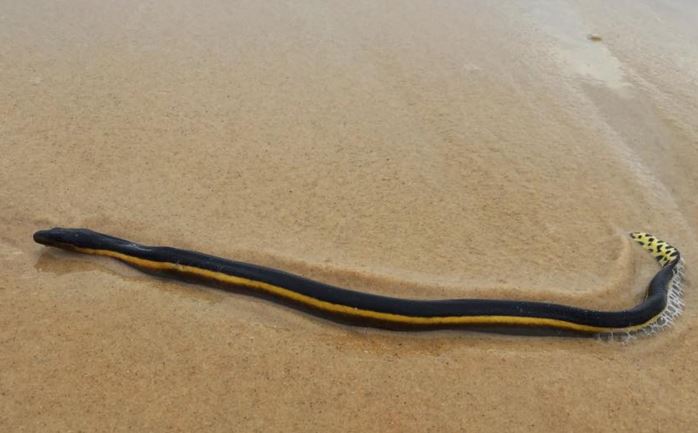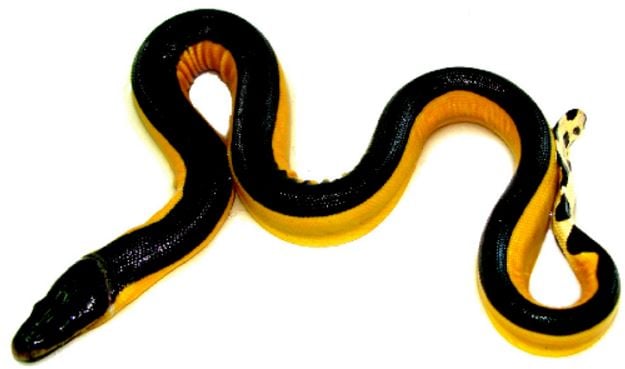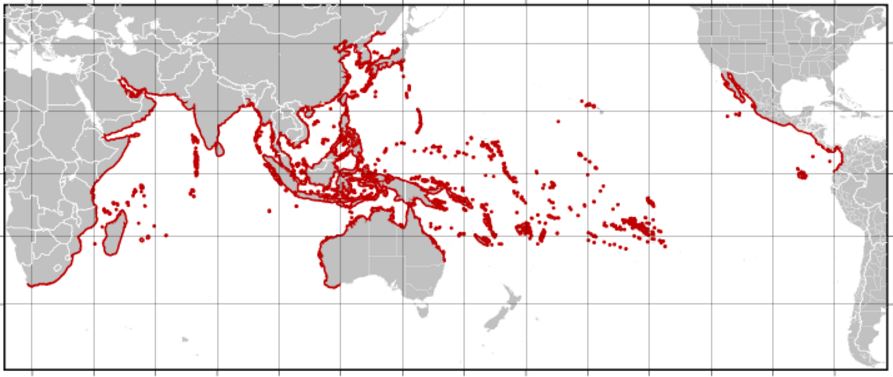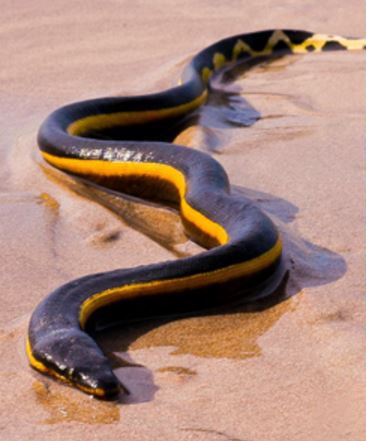Extremely venomous yellow-bellied sea snakes have been found washed ashore on the beach in New South Wales, Australia. Locals have been told not to approach the aquatic snake, which lives in the surface layers of the open ocean and is ten times more venomous than the African cobra.
Local authorities believe rough seas washed the venomous sea snakes onto the shore.
The tropical sea snake should not be touched, even if it looks dead. It has a persistent bite reflex which is active up to one hour after death – even after decapitation. Its venom is capable of seriously harming and even killing a human.
The yellow-bellied sea snake (Pelamis platura), also known as the pelagic sea snake, is found in the tropical oceanic waters across the world, excluding the Atlantic Ocean.
 Carolyn Larcombe posted this photo in Facebook with the following comment: “This was taken at Congo, just south of Moruya, this morning. These are venomous tropical pelagic sea snakes, only occasionally found this far south, where the water is mostly too cold. Its presence might be related to storm currents.” (Image: www.facebook.com)
Carolyn Larcombe posted this photo in Facebook with the following comment: “This was taken at Congo, just south of Moruya, this morning. These are venomous tropical pelagic sea snakes, only occasionally found this far south, where the water is mostly too cold. Its presence might be related to storm currents.” (Image: www.facebook.com)
According to abc.net.au, Carolyn Larcombe, from Burra near Canberra, saw a small yellow-bellied sea snake while walking along Congo Beach, 8 km southeast of Moruya on NSW’s beautiful South Coast – about two hours by car from Canberra.
She said she was struck by the snake’s unusual colouring – a yellow belly with dark slate blue on top, and a dark-spotted tail shaped like a paddle (aids swimming).
Ms. Larcombe said:
“It was very quiet (and) I was able to put it over a stick and put it back in the water.”
Later on she saw a larger one with the same features, and also managed to return it to the water.
Ms. Larcombe said:
“I’m not scared of snakes; I was being very, very careful. I thought they had a better chance of survival back in the water than up high and dry on the sand.”
“They’re very, very beautiful. It’s always a treat to see new and different things and it’s good to think that they may have survived back in the water.”
 A yellow-bellied sea snake. Its distinctive colouring warns predators to keep away. (Image: threatenedtaxa.org)
A yellow-bellied sea snake. Its distinctive colouring warns predators to keep away. (Image: threatenedtaxa.org)
About the yellow-bellied sea snake
The yellow-bellied sea snake, which is about 1 metre long, has a wider geographic range than any other reptile species, except for some types of sea turtles.
They can be seen off the coast of east Africa, from Djibouti in the north to Cape Town in the south, throughout the Indian Ocean, the Pacific, as far south as the northern coast of New Zealand, and all the way to the western coast of the American continent.
The Marine Education Society of Australia says the snake lives on the surface layers of the sea and drifts passively in warm currents. On land, the animal is quite helpless. Sea snakes that are washed onto beaches during storms rarely manage to make it back to the sea.
 Pelamis platura has an extensive geographical distribution – from east Africa to the west coast of the American continent. (Image: Wikipedia)
Pelamis platura has an extensive geographical distribution – from east Africa to the west coast of the American continent. (Image: Wikipedia)
They feed on small fish, which they immobilize with their potent venom. They are cautious hunters, approaching their prey very slowly or waiting motionless on the surface and ambushing small fish that come to shelter underneath it.
The yellow-bellied sea snake has very few enemies (predators), unlike other sea snake species. Their bright colours serve as a warning to other animals that they are either poisonous or possibly toxic to ingest.
Females give birth to two to six live young – they do not lay eggs. Although the young are born with substantial fat reserves, they will usually feed on their first day of life.
The majority of sea snakes respire through their skin. The yellow-bellied sea snake gets 20% of the oxygen it needs through its skin. This means it can spend a long time underwater before coming up to breathe. They remain underwater from 10 to 90 minutes, according to Waikiki Aquarium.
Video – The Yellow Bellied Sea Snake

